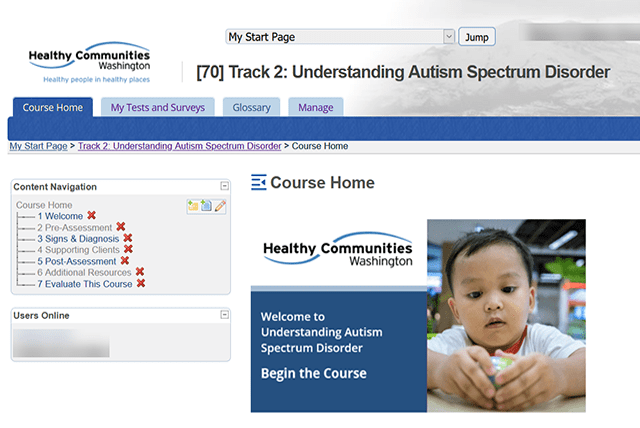One person, a tightknit team, or a whole organization. We at Talance have built training programs, curricula, and educational material for projects of all sizes, setting new standards for delivering engaging training that people look forward to with each and every project.
These projects can take on a number of formats: a workbook for elementary school teachers; a toolkit for health workers to use in the field; an online college curriculum for universities and teaching hospitals. We’ve worked with a wide range.
The key to keeping projects like these organized is to start with being organized from the very beginning.
If you’re embarking on an online training project, you might not know where to go next.
When employers start planning for an online training program, they should minimally start by looking at what their students need, what their organization needs, and what kind of technology needs. Here are some questions you can start with.
Good news: most e-learning projects follow a set format that’s designed to organize the process and guide the team to the next step in the easiest way possible.
Where to Start Your Next Project
With that in mind, we put together this guide for people like you who might be embarking on your first remote training project. Here are the basic steps you can expect when you start working with a company like Talance or create your own in-house project. (Ready to hire a vendor? Start with this article on hiring your learning team.)
In this comprehensive article, we will dive deep into the critical first phase of the ADDIE model – the analysis phase. By mastering this essential step, you’ll gain valuable insights into your learners’ needs, organizational requirements, and technological considerations, ensuring a solid foundation for a successful remote training project.
Get ready to discover the secrets to conducting a thorough training needs assessment and unlock the key to delivering exceptional online training experiences that surpass expectations. Let’s dive in!
ADDIE Starts with Analysis
Many online learning projects start with ADDIE. This is an acronym that stands for Analyze, Design, Develop, Implement, and Evaluate.

ADDIE is a model in instructional design that can help think about and plan a course design. While it seems rigid, the model can be adapted for many projects and can be adapted depending on what kinds of materials you already have.
The Analysis Phase
The A in ADDIE is the first phase of any online learning project (and many other programs besides): analysis.
The analysis phase helps you understand what the instructional problem is so you can solve it. You’ll ideally answer these questions in the analysis phase:
Who’s the audience?
Establish who you’re training. Be specific as you perform this audience analysis. Note demographics, their existing knowledge of the subject matter, what their education level is, or what kind of barriers they might have, such as limited access to computers. The answers to all these questions will help shape the way you deliver training information.
What goals are you trying to reach by training them?
By the time your learners complete the training program, what should they be able to do? This is how you define the learning objectives for a course or program. The objectives form the backbone of any educational materials you or your vendor create.
In order to reach those goals, what skills, knowledge or behaviors do they need?
This portion of your analysis in the ADDIE model should define what kinds of skills are necessary for achieving your online learning. They’re not the same thing: skills are the essential tools necessary to reach an objective.
For example, imagine you’re working on a course on social diversity. Here’s one of your learning objectives:
Communicate social, cultural, and economic information to public and professional audiences.
That’s concise, but how will the learners communicate that information? They’ll need a host of skills, but the top of the list is probably communication skills. In your analysis, list this along with other skills your audience needs to successfully meet the course’s objective.
What resources do you have or need?
Now that you have a list of skills, you can start to think about the reality of building them by taking stock of resources. Reaching some skills will require the use of specific resources, such as equipment or hardware that your staff needs to be trained in. You might have these or need to get them.
Or your resources might be financial or staff-based. Following the ADDIE model, you might ask yourself:
- Do you need to hire a vendor to build the training?
- Do you have subject matter expertise already? Who is that person? Do you need to hire someone?
- What kind of budget do you need to make your project happen?
This list of resources will depend on the training, but putting together the list will help as you put together a team and a financial plan.
How will you know when you’ve succeeded in your training goals?
When the course is done, and your learners have completed it, how can you prove it? The ADDIE model for online learning requires that you specify from the start in what ways you’ll measure success for your program.
Many programs use evaluation metrics to show if a program is successful. Here are some common metrics used in some of the programs Talance has created:
- Enrollment rates – the number of people who signed up
- Logged in vs. completions – the number of people who signed up and also completed
- Learner participation – the number of pages or dates learners were online
- Total time spent in lessons – the total time learners spent reading, watching and completing activities
- Self-assessments – strengths and weaknesses that the learners rank themselves
- Knowledge-gain – the difference in scores between a pre- and post-assessment
- Satisfaction – data on how much your participants value the training
You can read more in 10 Training Metrics to Measure the Effectiveness of Your Remote Training Program.
Always Include Analysis
It’s important to start off all programs with this analysis phase, even though it can be tempting to just say, “Let’s train our staff in X skill!” If you follow the ADDIE model for online learning, skipping the analysis can add up to big losses, but careful planning will lead to years of success.
It’s also important that before you do anything to train your staff, find out what your stakeholders need from a program and what your employees need to learn. This will help you create a program that has a greater chance of success.
Depending on how much research you need to do, there could be other questions to ask during the analysis phase. Here are 17 questions you can ask in a training needs assessment if you want to see more in-depth.



